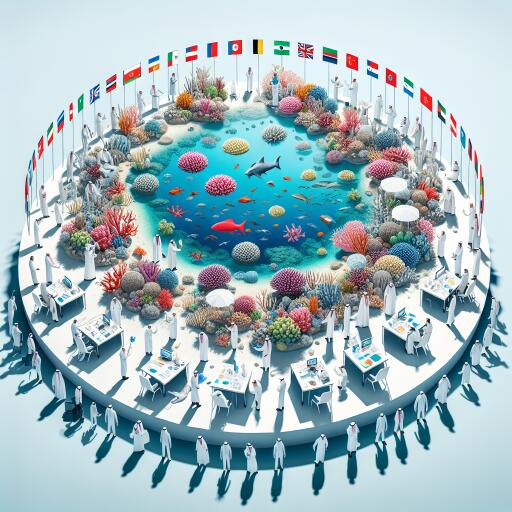
Diplomatic Ecosystem Aims to Save Red Sea Corals
Nearly two centuries ago, Charles Darwin set foot on the Galapagos Islands and encountered a natural puzzle. Despite the nutrient-poor, crystal-clear waters surrounding them, coral reefs thrived with life. Little did Darwin know, the secret lay within the coral polyps themselves. Hosting symbiotic, single-celled algae known as zooxanthellae, corals have harnessed the power of photosynthesis. These algae perform a vital role by converting sunlight into energy, producing oxygen and nourishing compounds that perpetuate a thriving marine ecosystem.
Zooxanthellae turn solar energy into a lifeline, supporting bacteria that evolve into food for complex marine life. With their intricate designs, coral reefs offer shelter to a multitude of species and stand tall as one of the planet’s richest ecosystems, akin to the lush rainforests.
Of particular interest today is the Red Sea reef. According to biochemist Anders Meibom, it holds the potential to withstand the threat of climate change, possibly remaining the last thriving reef by the century’s end. Recently, after leading an expedition to Djibouti’s Gulf of Tadjoura, Meibom returned with encouraging observations about these reefs. Even in these warming waters, the coral ecosystems show resilience not commonly found around the globe.
Typically, a rise in sea temperatures by 2°C can lead to coral bleaching, when the crucial symbiosis between polyps and algae collapses, leaving corals pale and vulnerable. While many coral ecosystems globally succumb to such stress, those in the Red Sea, particularly in its northern reaches, demonstrate exceptional resilience. These corals have withstood temperature increases as high as 5°C without bleaching.
Meibom attributes this resilience to a historical migration of corals over millennia, from the warm southern waters of the Red Sea to the cooler northern regions. Despite adapting to cooler temperatures, these corals retain genetic memories of warmer climates, explaining their tenacity in the face of warming seas.
The September expedition yielded positive insights: no bleaching indicators were found in the Gulf of Tadjoura’s corals, where temperatures are traditionally higher than the northern Red Sea.
“Even here in Djibouti, despite a historical rise of one or two degrees in water temperature, corals remain largely unaffected, which is incredibly reassuring,” Meibom noted. These hardy corals, metaphorically considered as the Red Sea’s ancestral reef inhabitants, hold the key to understanding thermal resistance.
Such knowledge is crucial for a broader comprehension of the Red Sea’s coral ecosystems. It is also the core target of the Transnational Red Sea Center (TRSC), an organization initiated by EPFL in 2019 under Meibom’s direction. TRSC’s ambitious mission, backed by cutting-edge genetic analysis and 3D mapping tools, aims to provide open-access data pivotal for regional conservation strategies against pollution, overfishing, and tourism impacts.
Engaging nations around the Red Sea, particularly Egypt with its extensive coastline, to come aboard this initiative could safeguard coral habitats. This collaboration also arrives at a critical juncture, as Egypt plays host to the United Nations Climate Change Conference (COP27).
Biologically, the Red Sea forms a unique, interconnected ecosystem. Yet, geopolitically, it is surrounded by nations experiencing instability and complex interrelations. Consequently, TRSC’s success is hinged on effective scientific diplomacy, a strategy supported by the Swiss foreign ministry. Already, Jordan, Israel, Sudan, and Djibouti are active participants.
According to Meibom, the goodwill and cooperation extended by Swiss ambassadors are invaluable. This sentiment finds echo in Swiss representatives who view this project as an opportunity to forge better ties and cooperation with the region, reflecting mutual environmental and economic interests.
Beyond environmental concerns, the economic imperative of coral preservation is paramount. For Red Sea nations, tourism—a significant economic driver—hinges on vibrant coral reefs. Despite tourism constituting a modest 3% of Djibouti’s GDP, plans are afoot to expand this sector through meaningful partnerships with countries like Switzerland.
In essence, the diplomatic efforts tied to the TRSC project exemplify a fruitful synergy between science and international relations. Like the zooxanthellae illuminating the coral reefs with sunlight, neutral scientific pursuits pave the way for diplomatic interaction, setting a precedent for research-friendly conditions. This nexus of multilateral dialogue is invaluable in confronting expansive global challenges such as climate alteration and biodiversity attrition.
Ultimately, in conserving these underwater marvels, we preserve a vital ecological and economic asset while promoting peaceful, collaborative international relations.





Leave a Reply